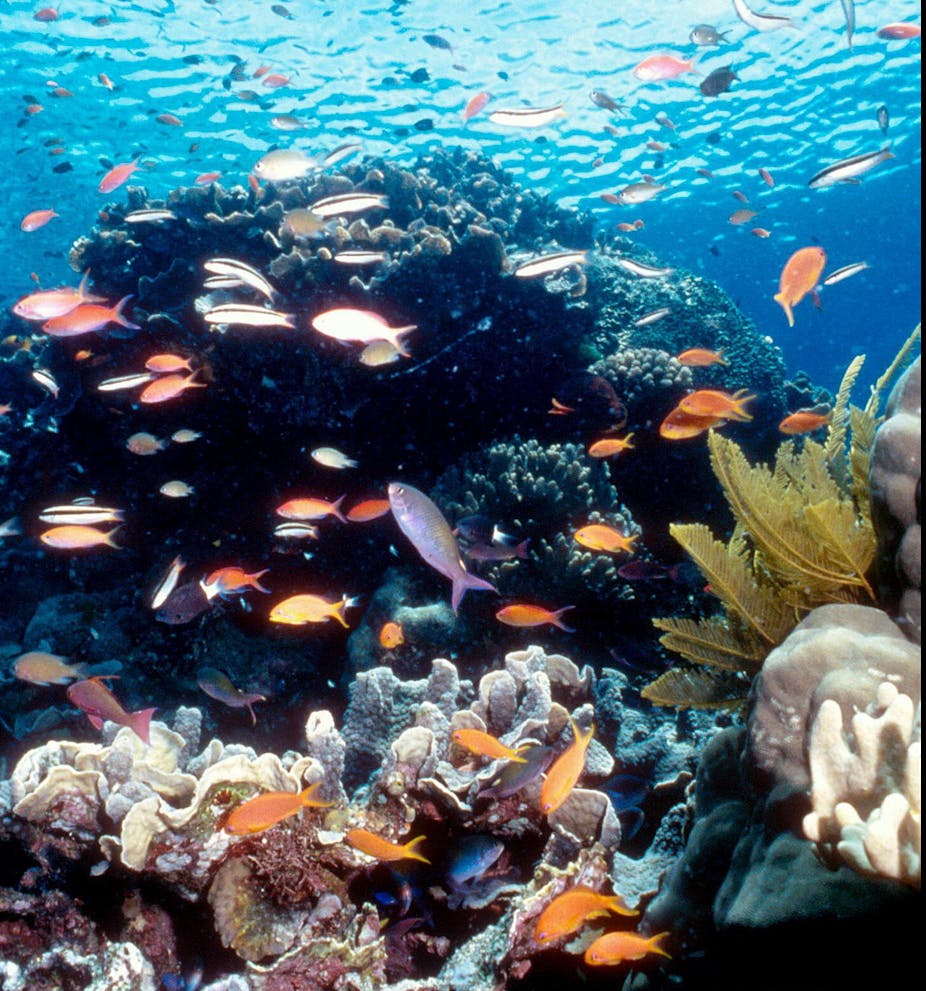The Great Barrier Reef is worth billions to Australia’s economy and is one of the world’s most significant natural features. We have a responsibility to protect it, and our other reefs, from the warming seas.
We now have the technology to preserve these important species, providing an avenue to bolster living populations and even to restore species if they are lost to an area.
Reefs: capturing carbon, fighting cancer, making money
Coral reefs are living, dynamic ecosystems. They are the rainforest of our oceans and have been on our planet for more than 200 million years.
Although all of the reefs in the world only occupy an area the size of Bolivia, they are eco-dynamos. They provide invaluable services to us.
They create natural storm barriers for coastlines, remove CO2 from the atmosphere, and provide nursery grounds and habitat for around 25% of tropical marine species.
Humans have already benefited from the diversity of coral reefs through the development of effective anti-viral and anti-cancer drugs, and further exploration could discover new pharmaceuticals.
Each year, coral reefs contribute up to $30 billion to the global economy. Australian reefs are worth over $1 billion annually. But no one knows how the loss of coral reefs might affect our global ecosystems and economies.
And we’re destroying them…
Unfortunately, coral reefs are experiencing unprecedented levels of degradation because of us. Locally, reefs are impacted by pollution and sedimentation from poor land-use practices, nutrients from farms and waste treatment plants.
Destructive practices, such as dynamite fishing, trawls, and boating also take their toll.
Globally, increased levels of greenhouse gasses are warming our oceans, making them more acidic and causing the coral to stress, bleach, and be more susceptible to newly emergent diseases.
Coral relies on photosynthetic algae that lives inside it for food. When sea temperatures are unusually high, coral loses this algae in a process known as “bleaching”.
If high temperatures are prolonged by days or weeks, the coral can die. And although we can sometimes predict when bleaching may occur on some reefs, there are no means yet to mitigate this damage.
A world without reefs
If reefs were to disappear, many of the fish that we depend on as essential food sources today will become luxury items.
According to Cassandra de Young of the UN Food and Agricultural Organization, with over 1 billion people on the planet already hungry, the disappearance of seafood may cause great instability in food supplies around the world.
Unless we take action now, coral reefs and many of their associated animals may cease to exist within the next 50 to 100 years, causing the first global extinction of a worldwide ecosystem within our history. It’s no wonder the Chair of the IUCN’s Species Survival Commission, Simon Stuart, lists corals as one of the planet’s three major species extinction crises.
Unfortunately, saving reef habitat alone will not stop the decline, because many of the most serious threats are global rather than local. We can protect our reefs from pollutants and disturbance, but warming seas present an ongoing threat of bleaching.
The case for freezing
Fortunately, a frozen repository for the world’s most endangered coral species has now been developed by the Smithsonian Institution partnering with many international organisations.
Genetic banks comprised of live or frozen biomaterials hold strong promise for basic and applied research and conservation of species and genetic variation.
Frozen material can be thawed one, 50, or, in theory, even 1,000 years from now to restore a species or population. Done properly over time, samples of frozen material can be reared and placed back into ecosystems to infuse new genes and vigor into natural populations.
This will help to enhance the health and viability of wild stocks, and if needed, to potentially reseed our oceans.
Within these repositories are cells that are frozen, but alive. Frozen sperm from the endangered Elkhorn coral (Acropora palmata) and the Mushroom coral (Fungia scutaria) have been successfully preserved, thawed and used to fertilize fresh coral eggs.
But sperm alone is not an effective worldwide conservation tool, because so much must be preserved to ensure large numbers of fertilized embryos. Much like human eggs, coral eggs and larvae cannot currently be cryopreserved, because their high fat content results in destruction after freezing.
Toward that end, embryonic coral cells from the Mushroom coral (Fungia scutaria) have been cryopreserved and banked.
These frozen embryonic cells will be crucial for developing new culture techniques to aid in coral disease studies and in sorting out stem cells where one day each frozen stem cell might be coaxed into developing into an adult coral.
These ex situ conservation techniques could be applied to the Great Barrier Reef very soon with the collaboration of multiple partner organizations around Australia and the USA, such as the Australian Institute of Marine Science, Monash University, Taronga Zoo and the Smithsonian Institution.
A sound investment
Although the future for our marine ecosystems seems grim, the cost of ex situ conservation to preserve our reefs is minimal compared to the potential costs of doing nothing and allowing our coral ecosystems to collapse.
Given the changing nature of our oceans and the stress these changes are placing on our coral reefs, a bank used many years in the future (when many of these dangers, such as increasing temperatures, have been reduced) would have the greatest conservation benefit.
Can we do this? Yes, the technology is in hand.
Should we do this? Yes, it gives our future generation options, as to whether the maintenance of coral reefs is important.
Keep in mind that these conservation processes are just the very beginning of using a multi-disciplinary approach that includes complex biomedical techniques to aid conservation and ecosystems.
As our knowledge in areas like stem cells improves, so will our impact on the future of the Great Barrier Reef.
This piece was also authored by Andrew Heyward of the Australian Institute of Marine Science

